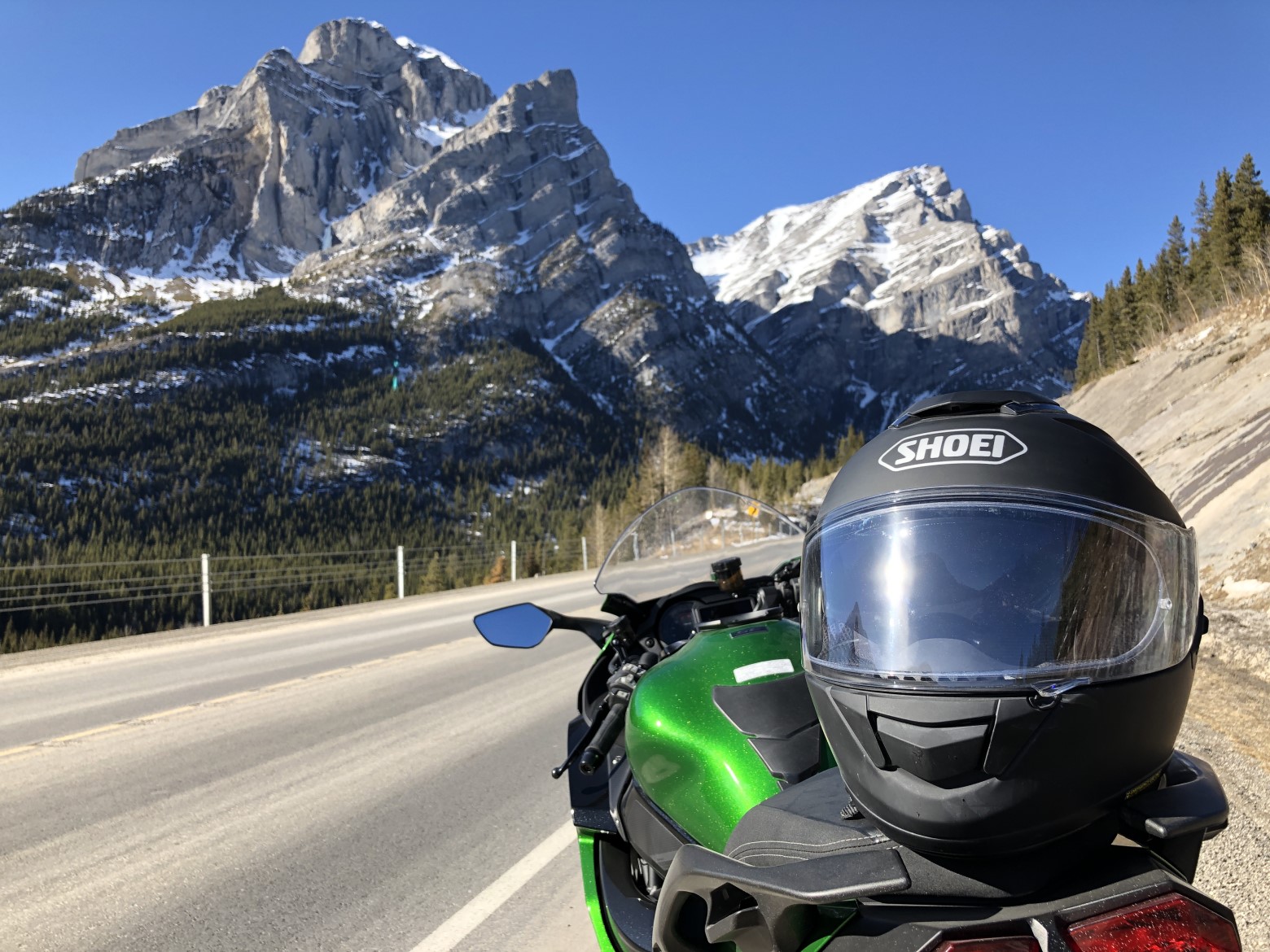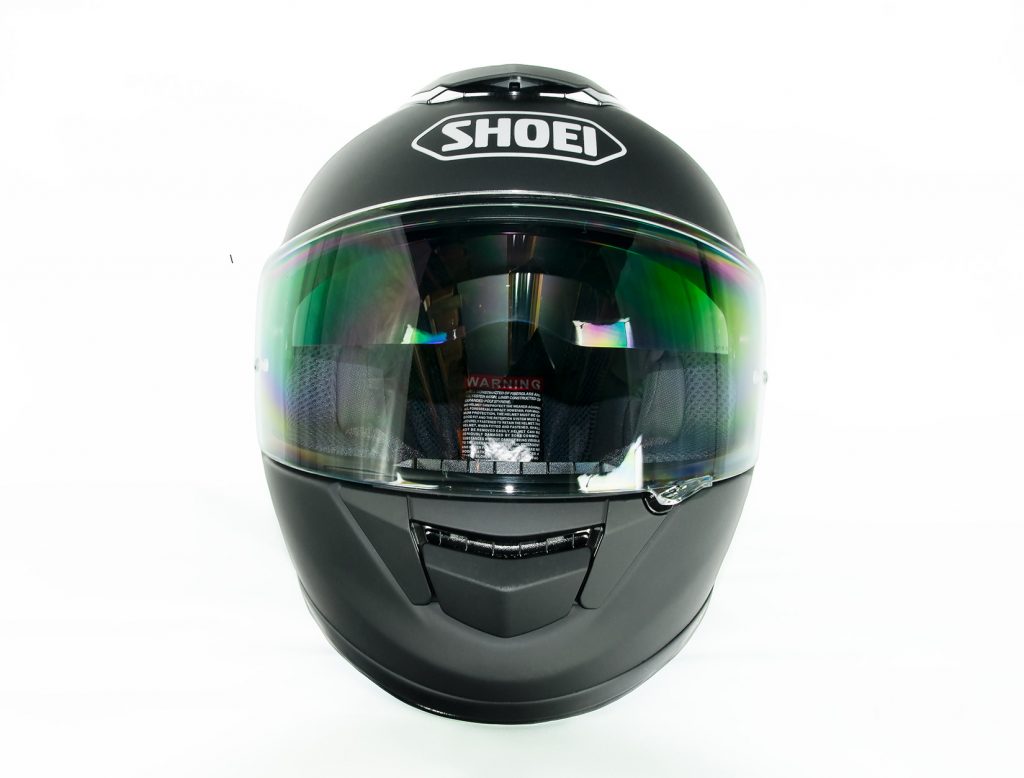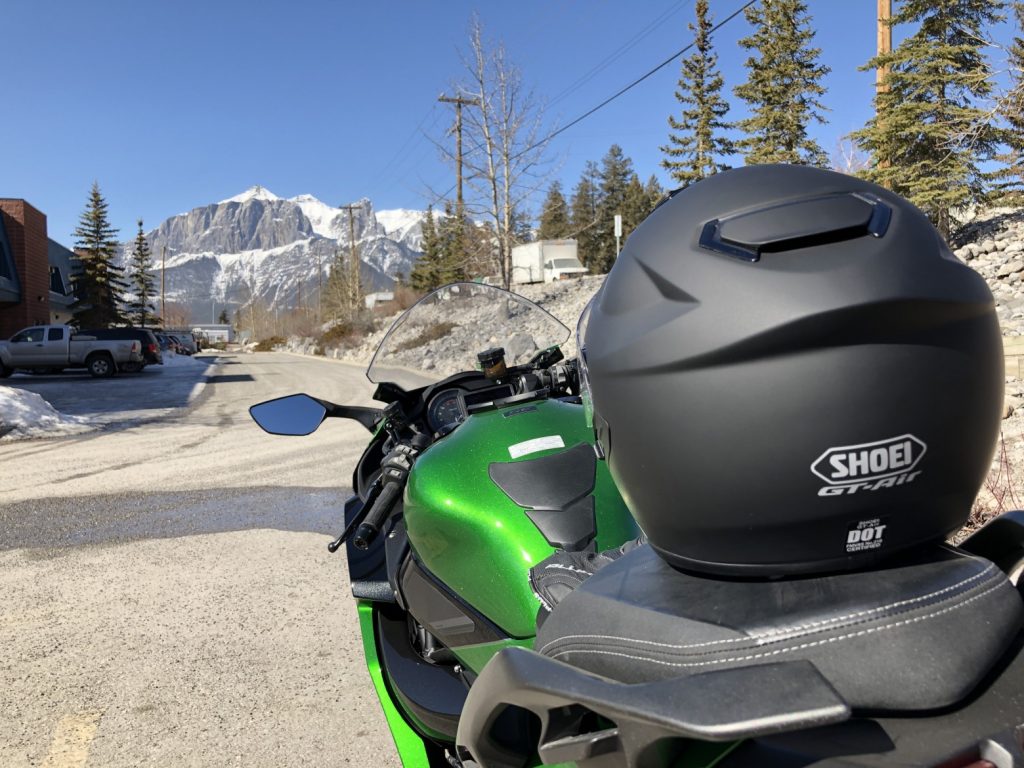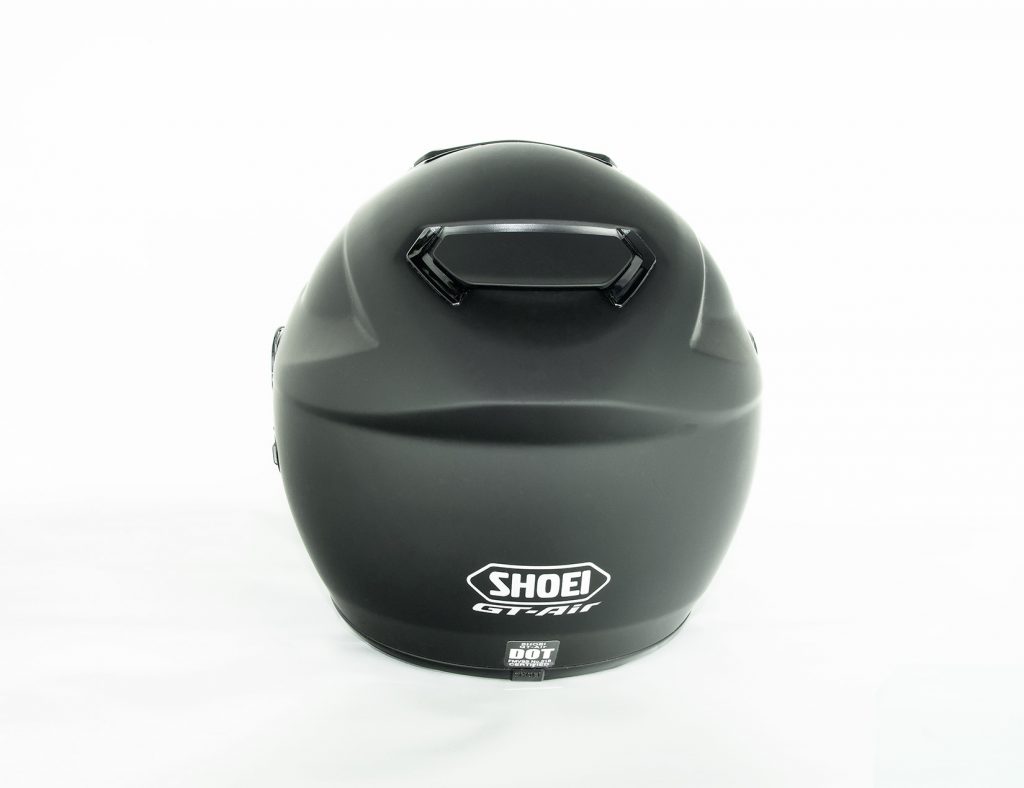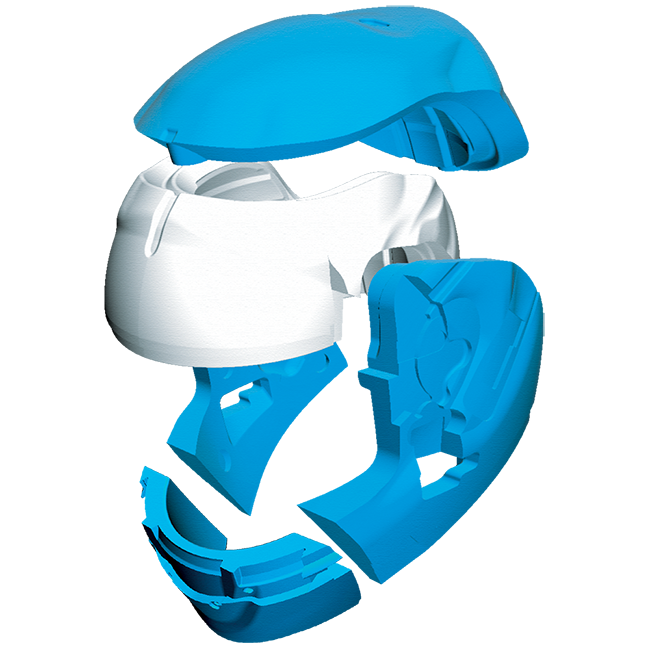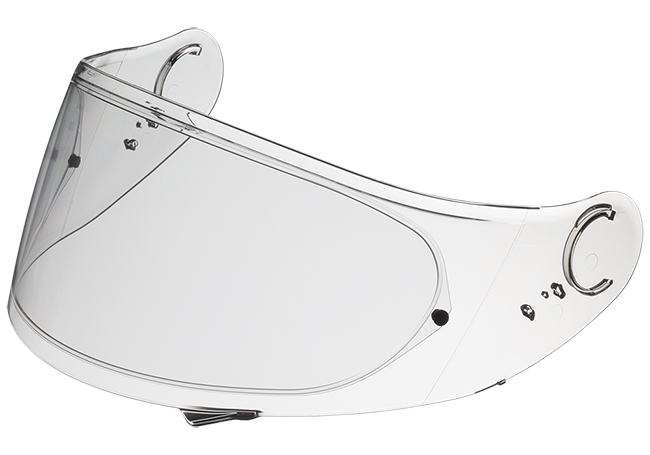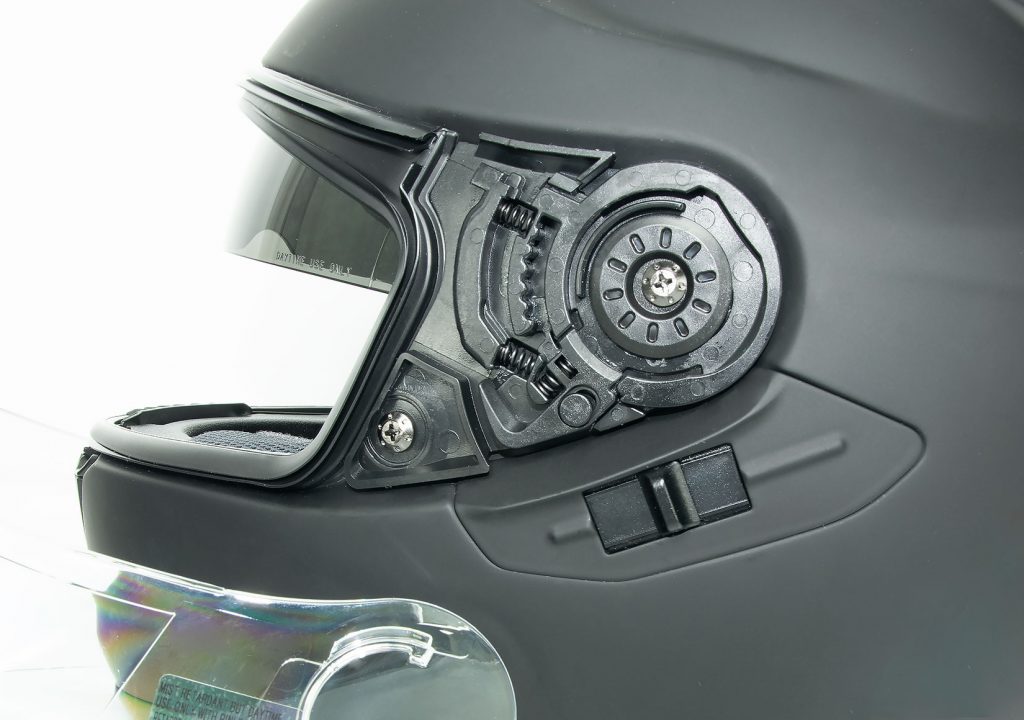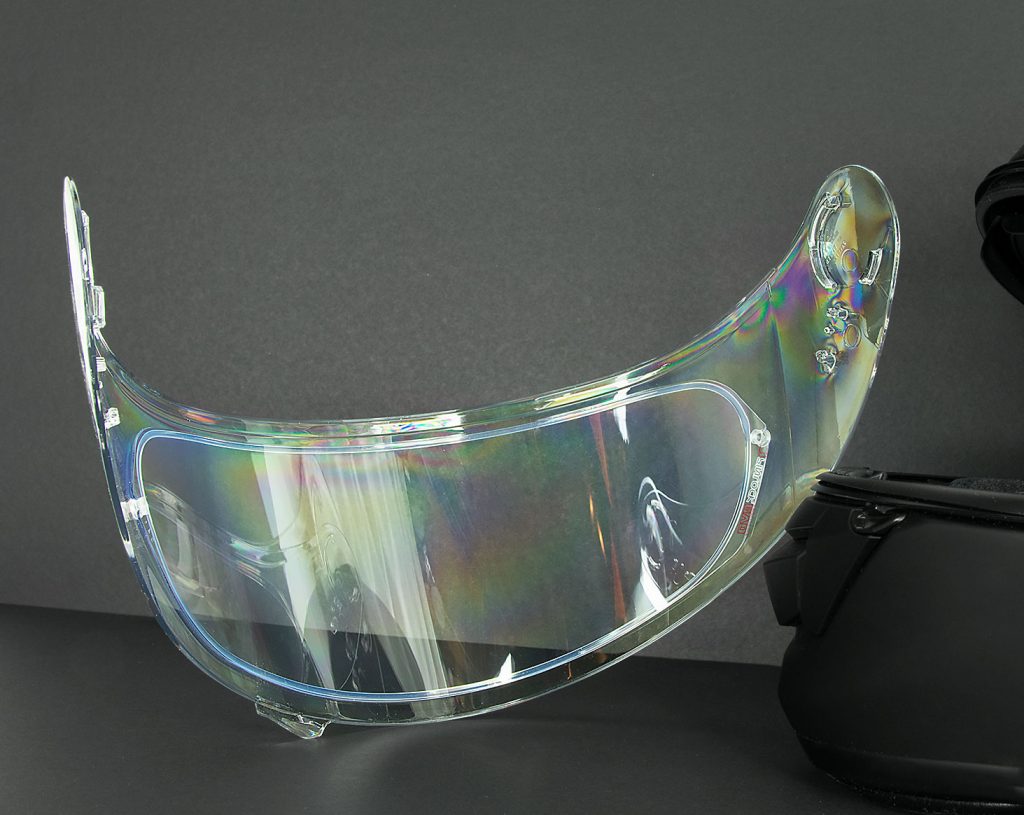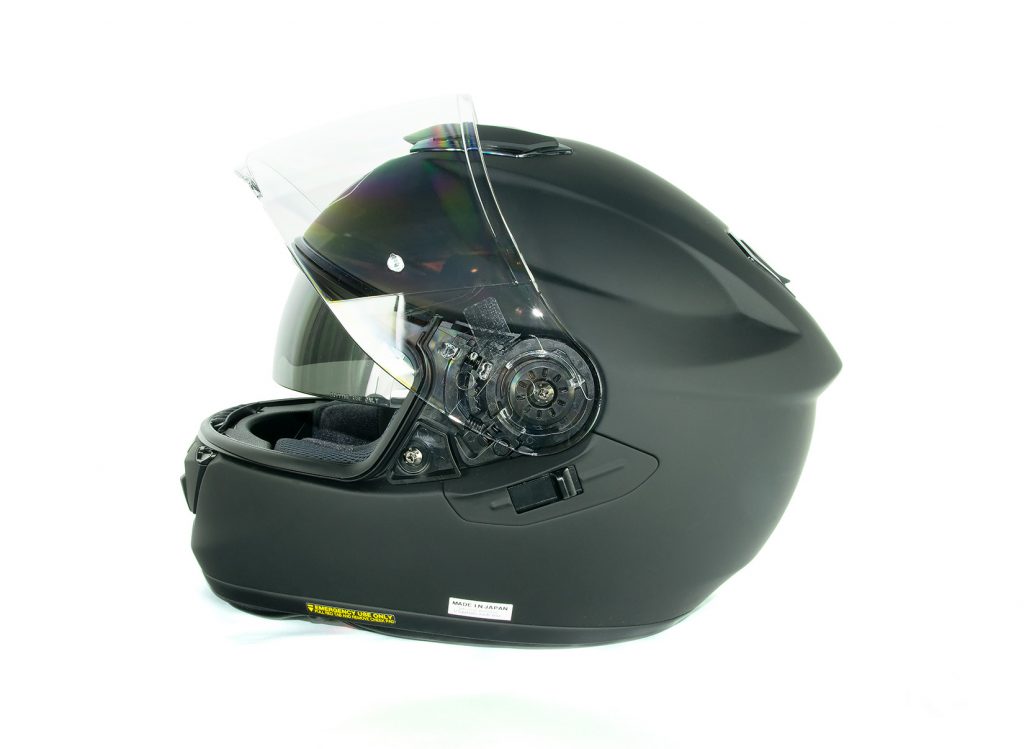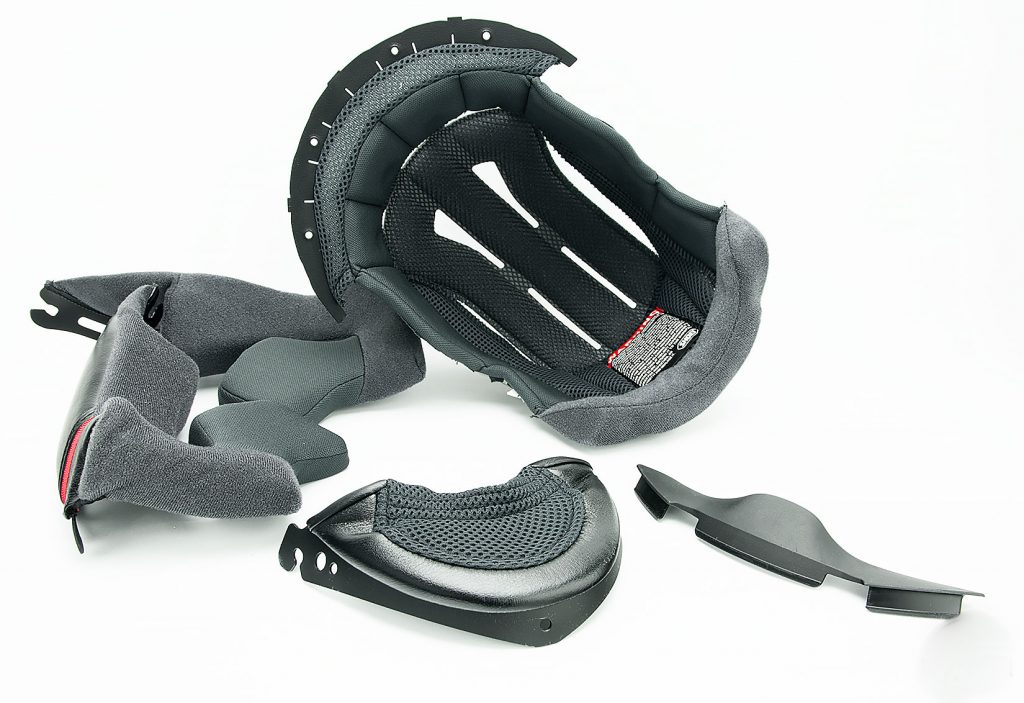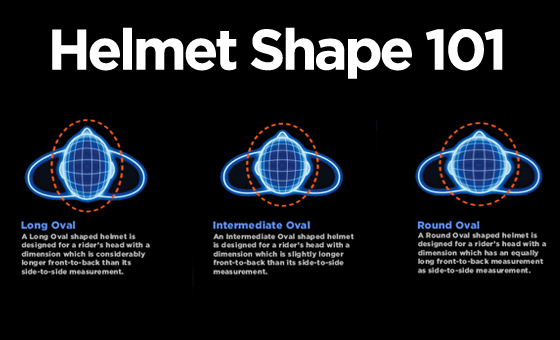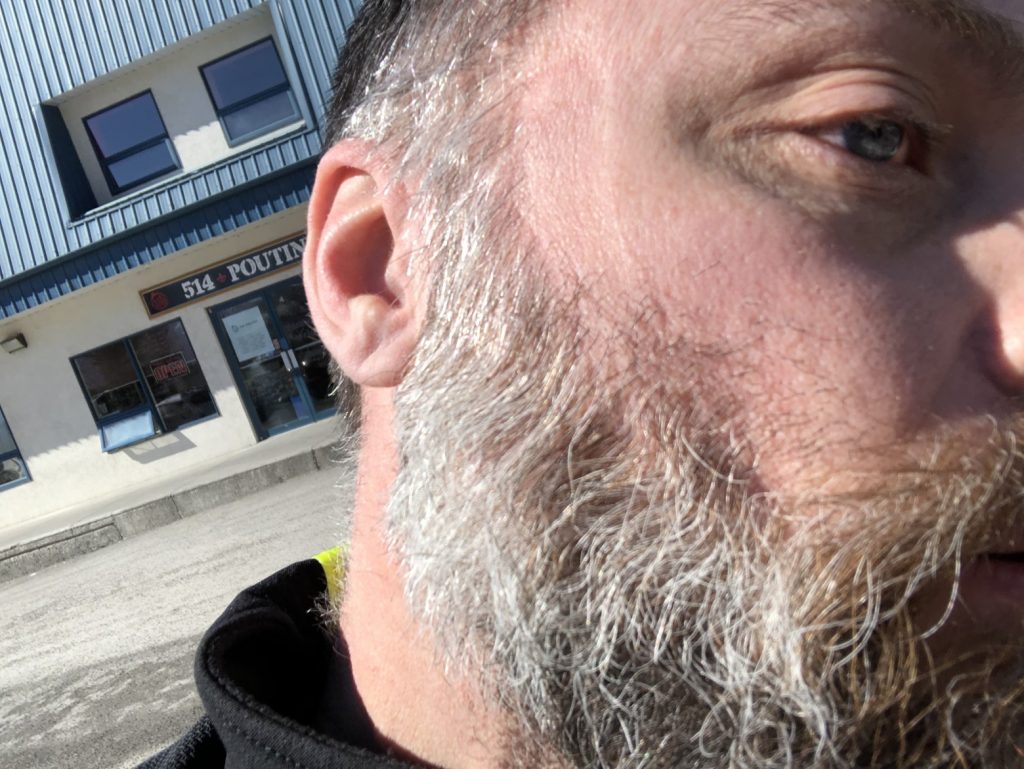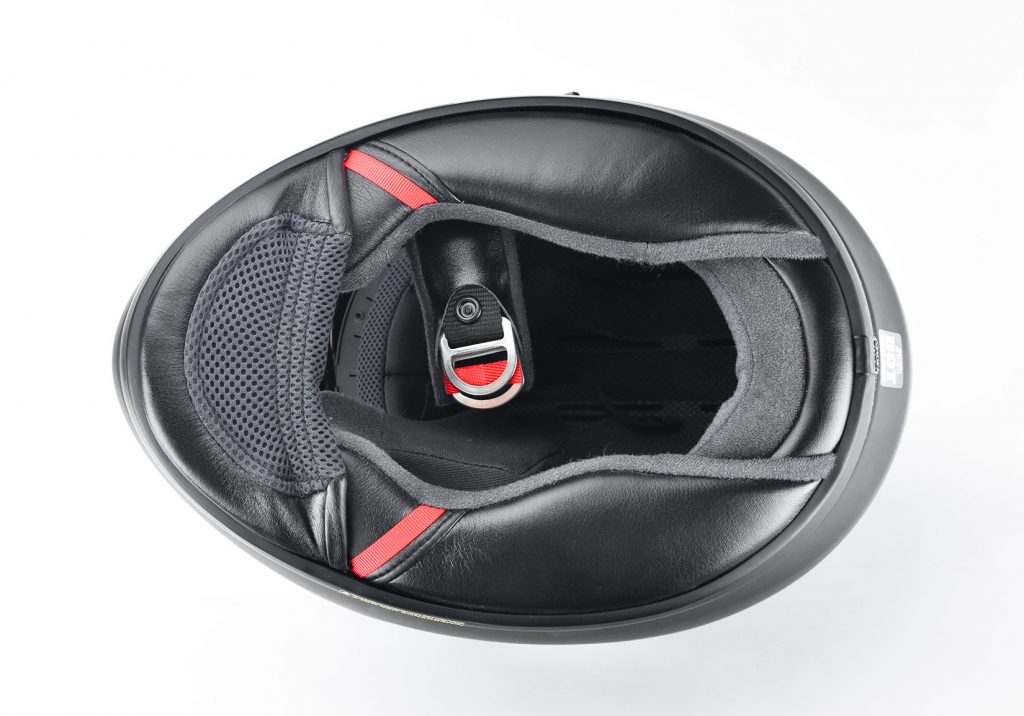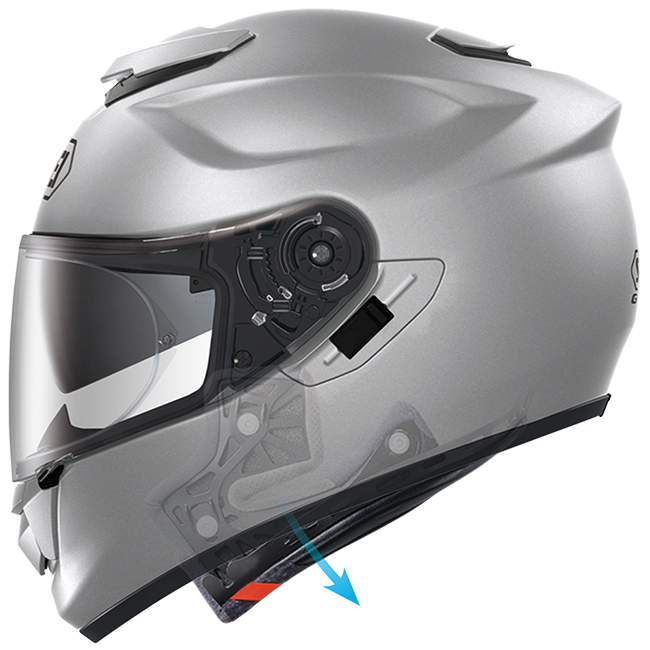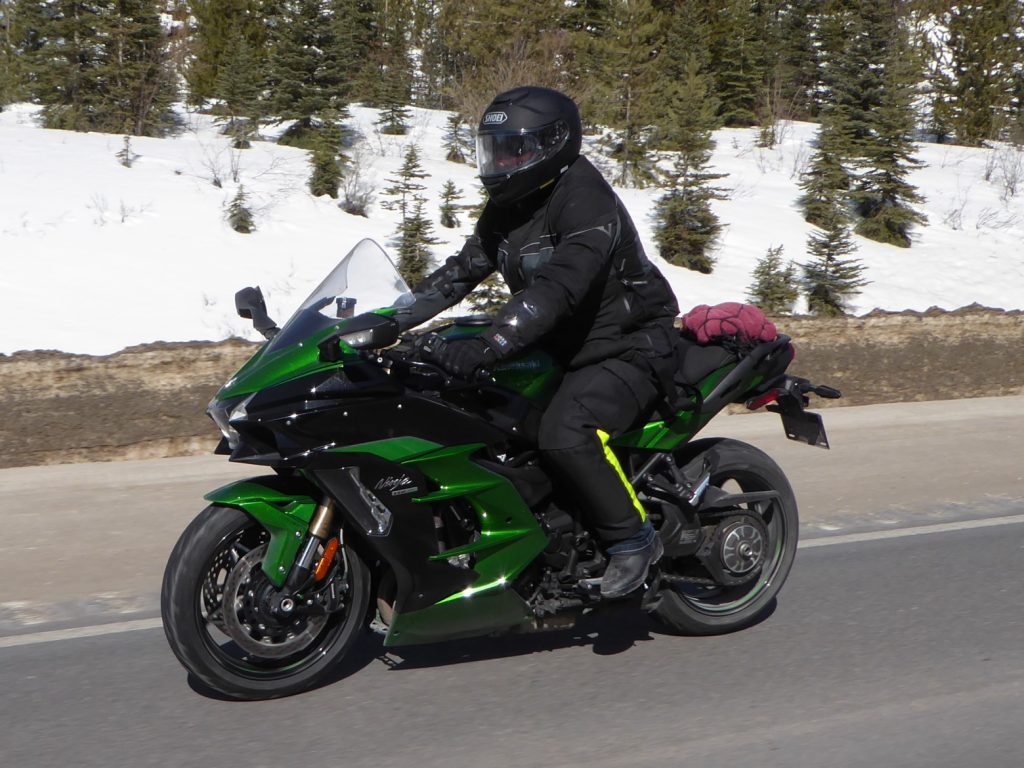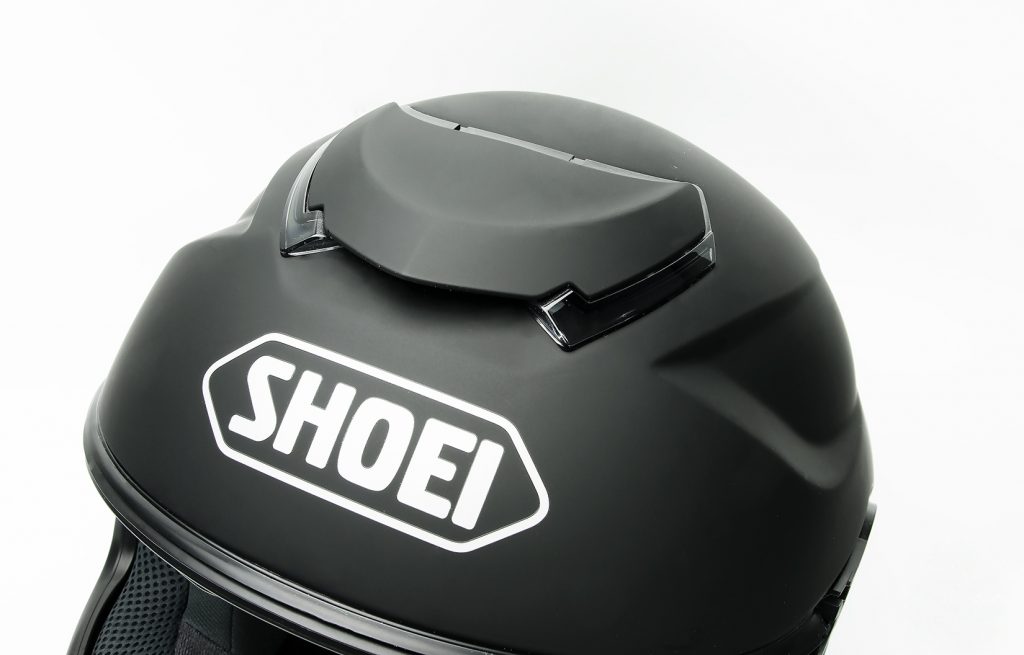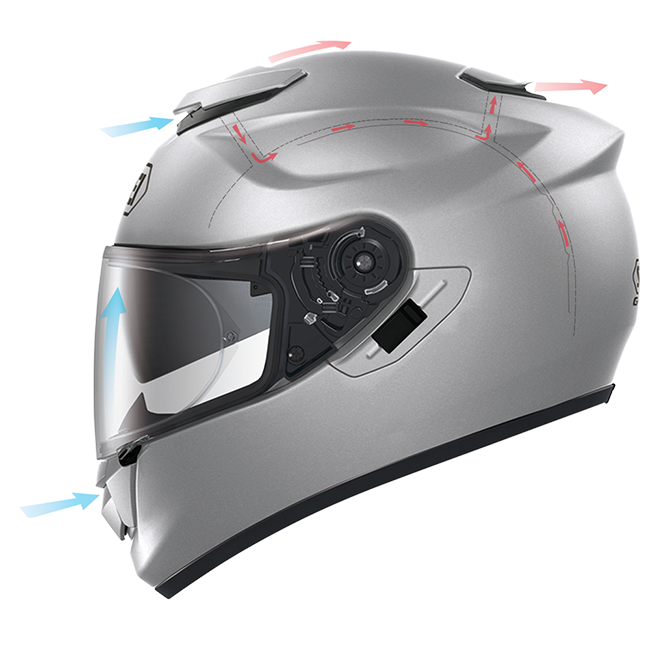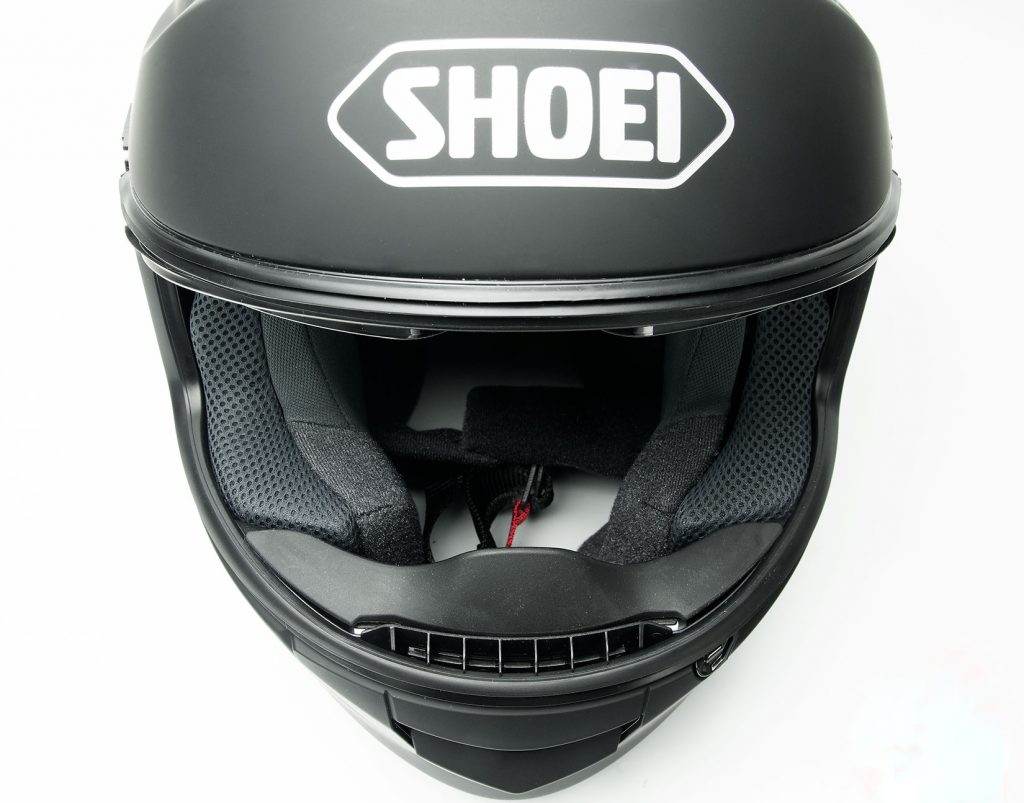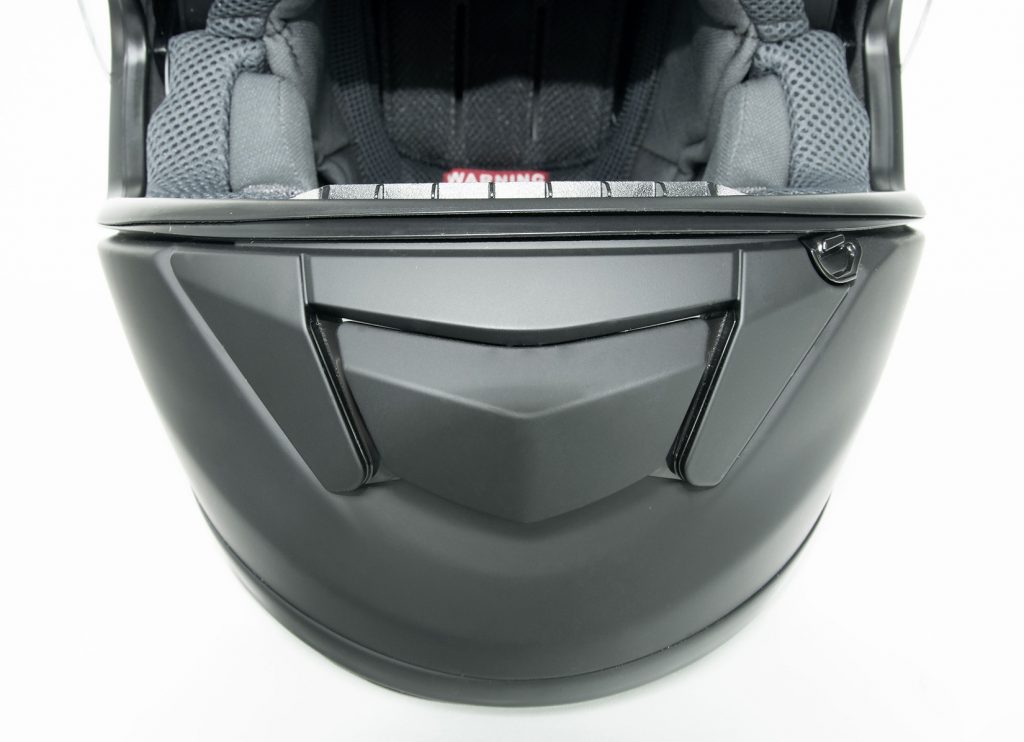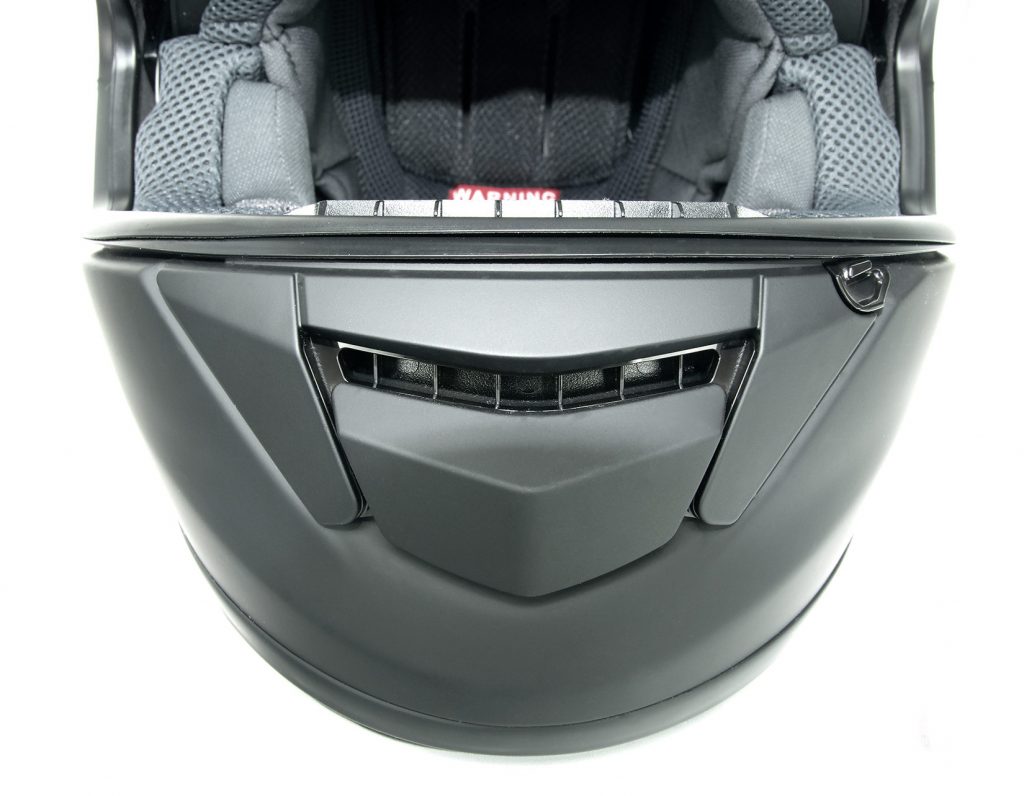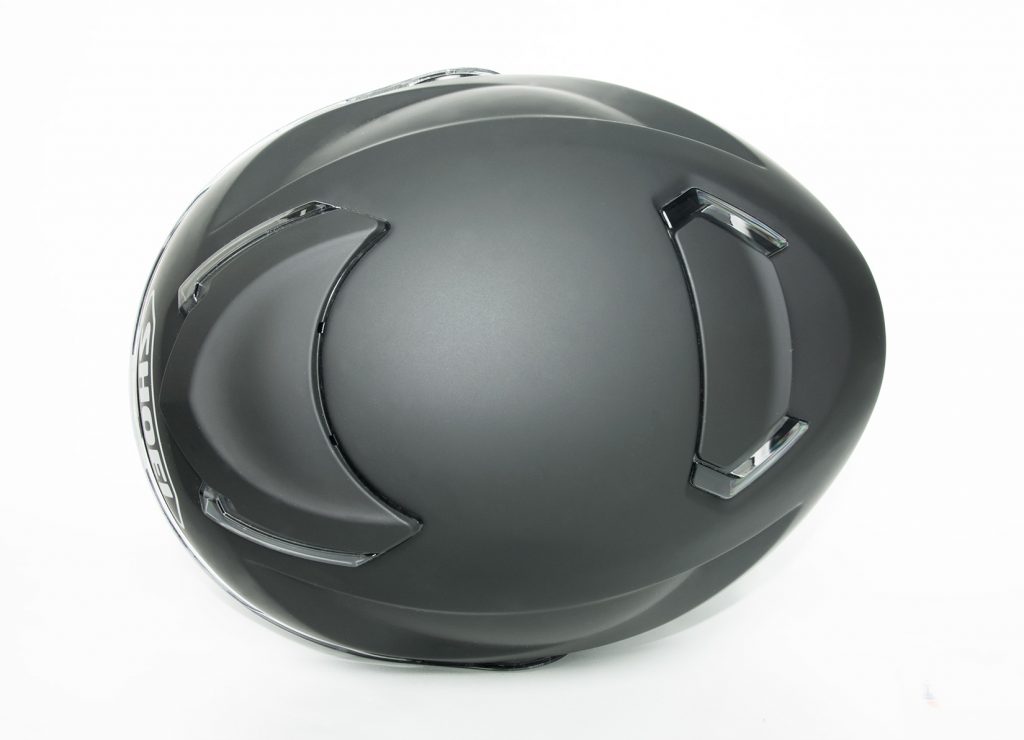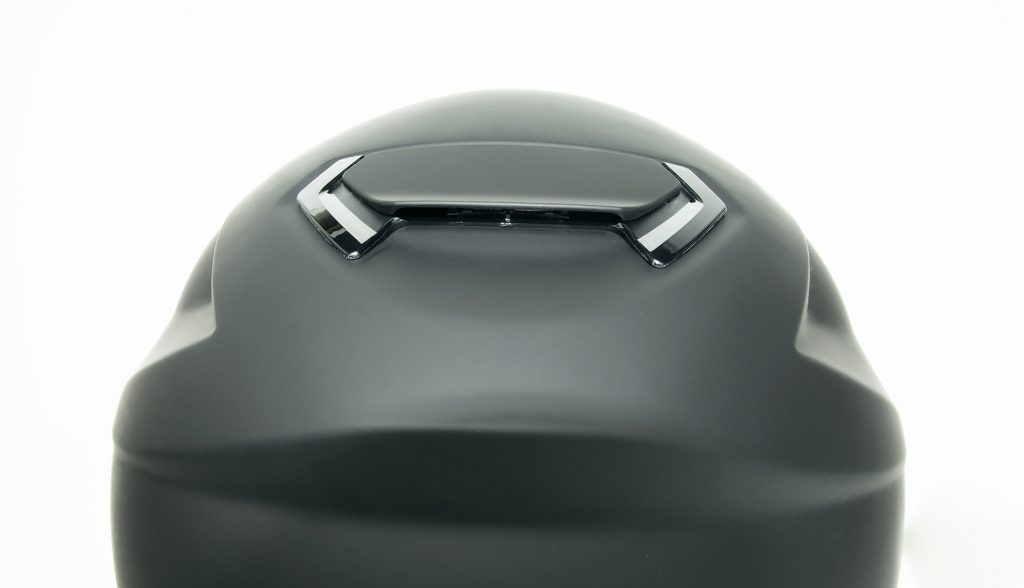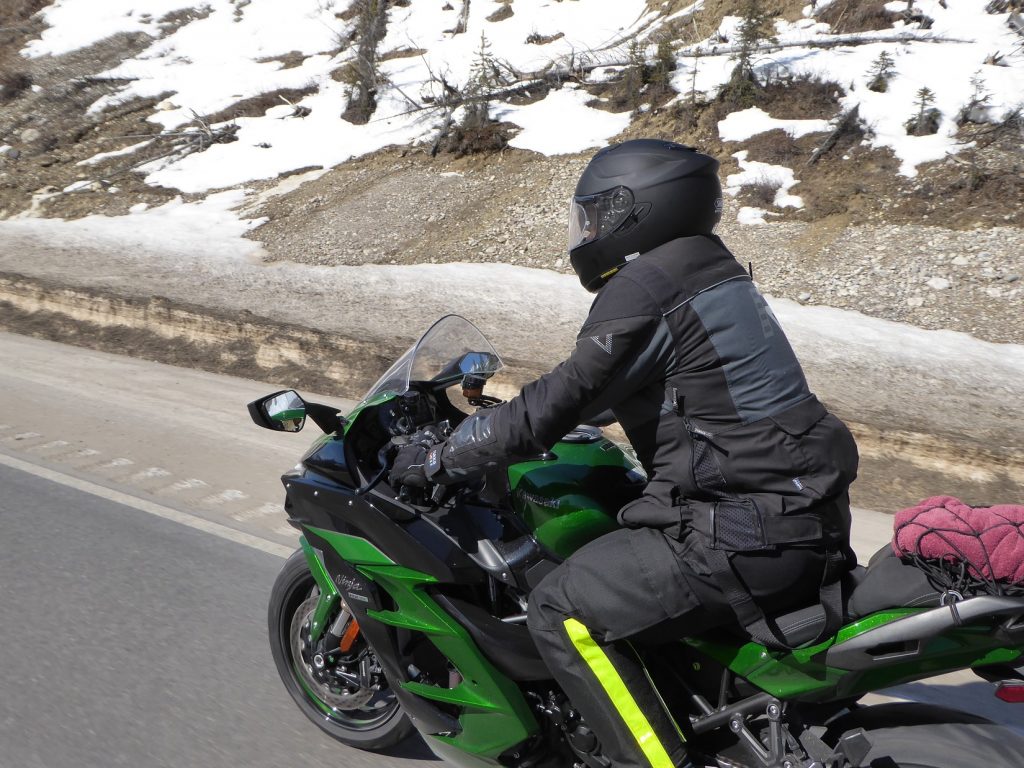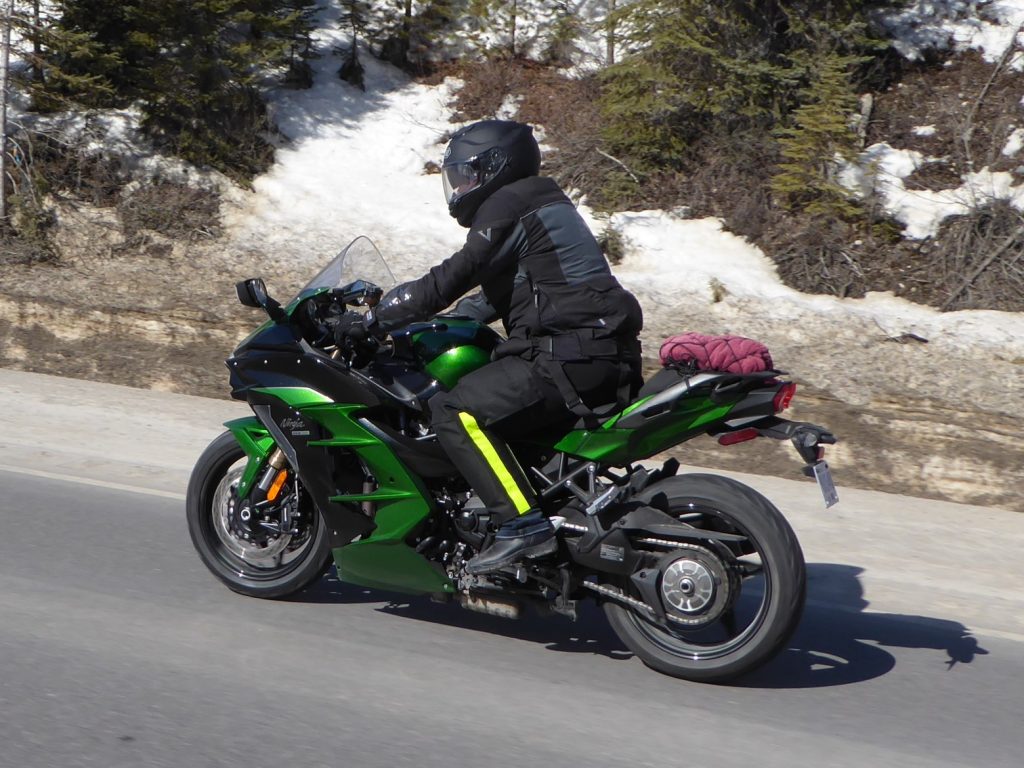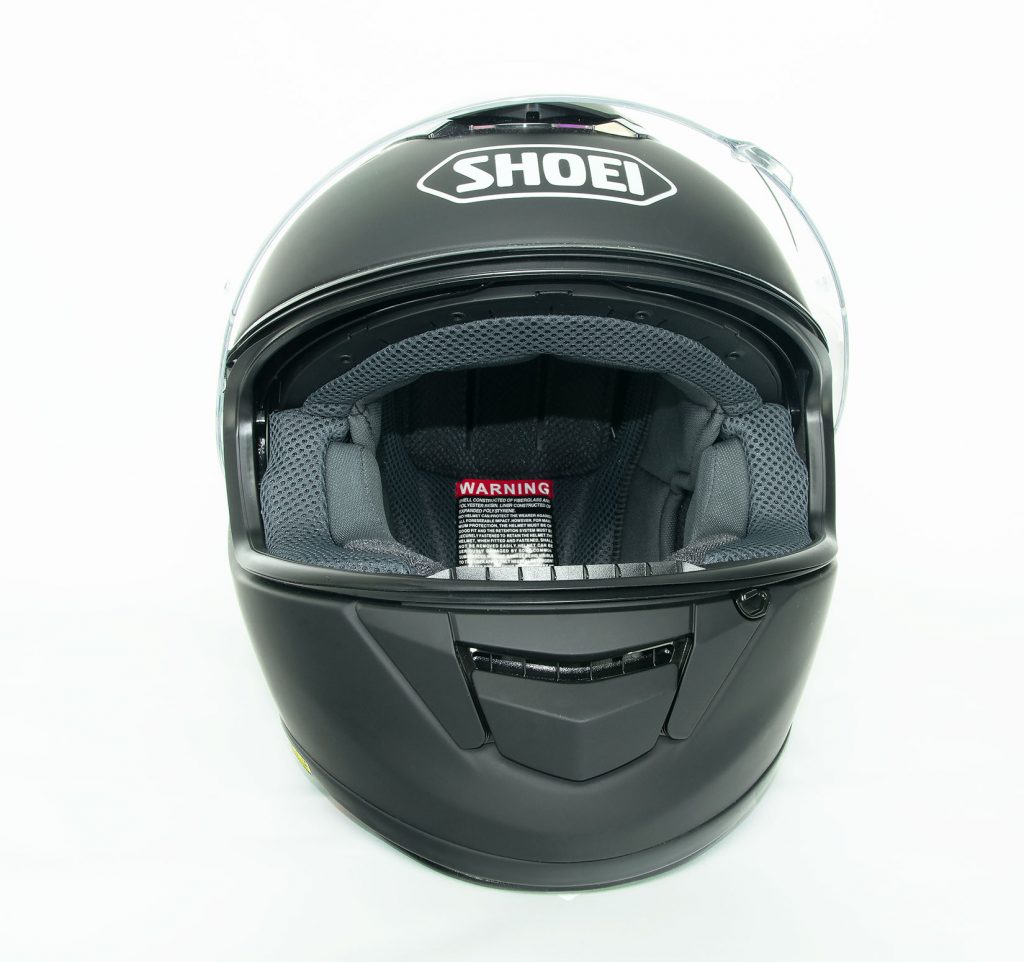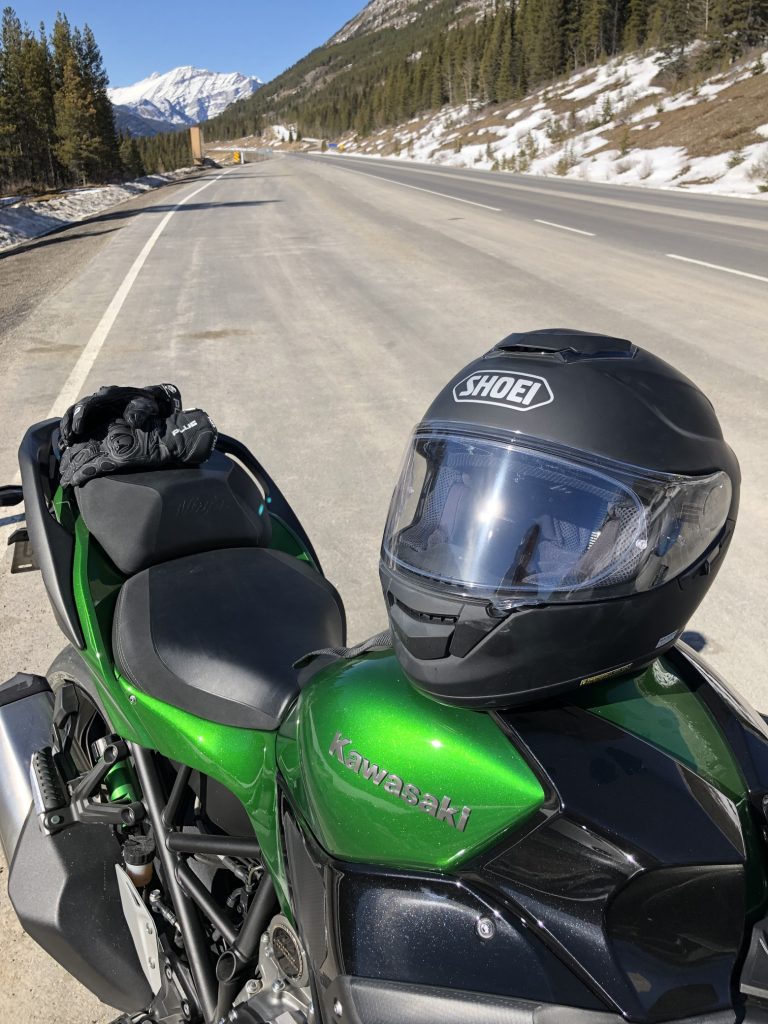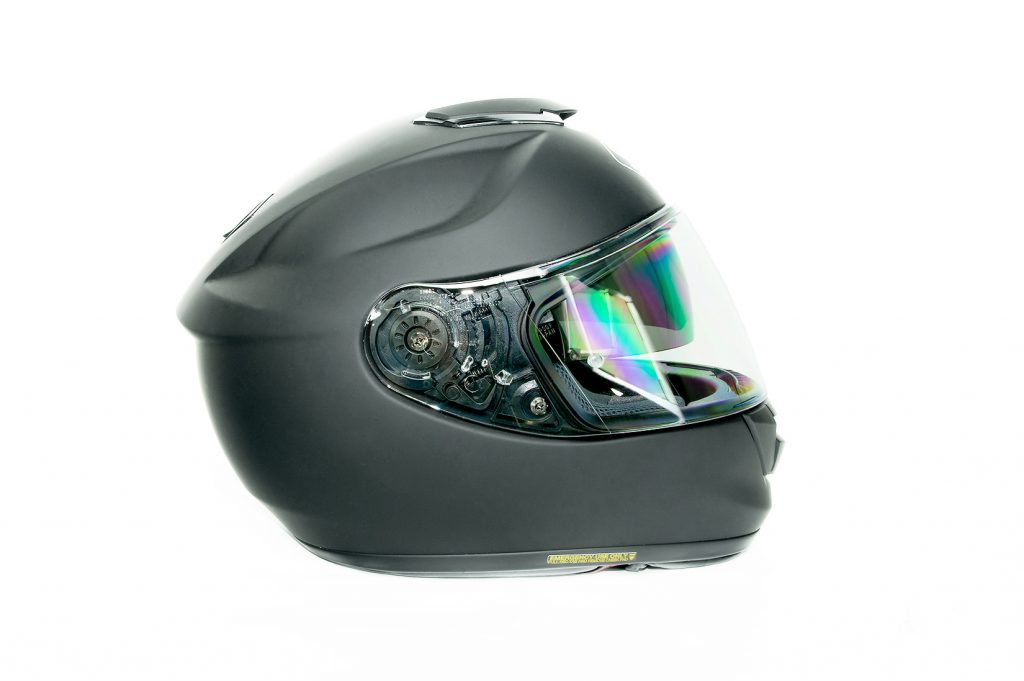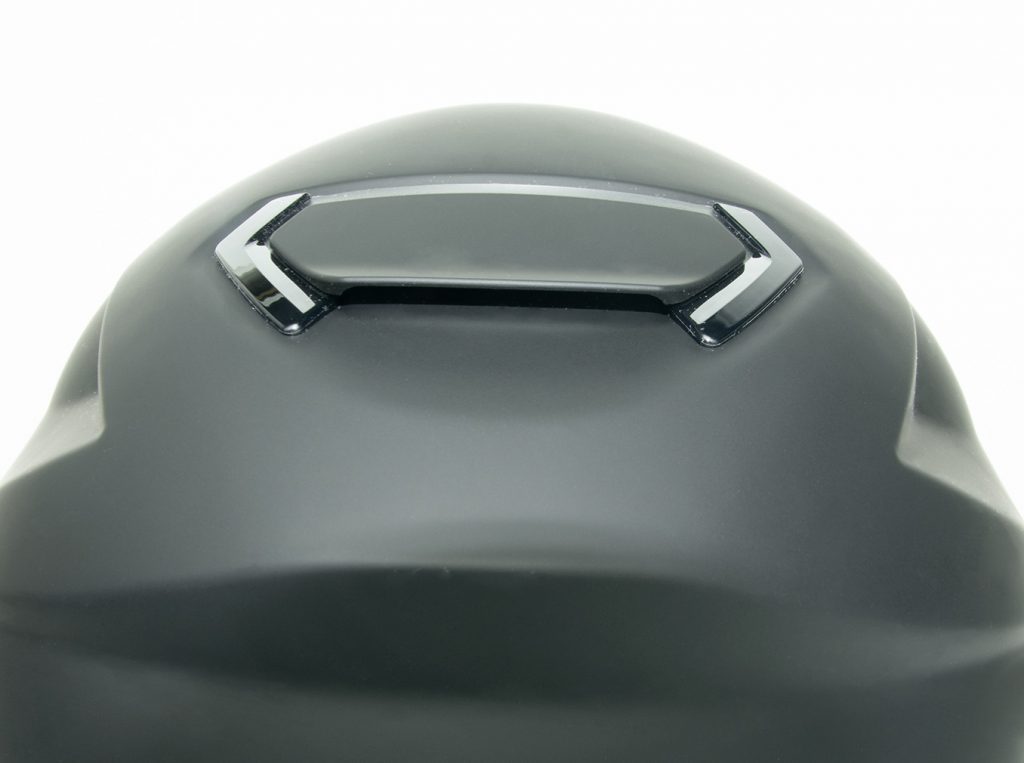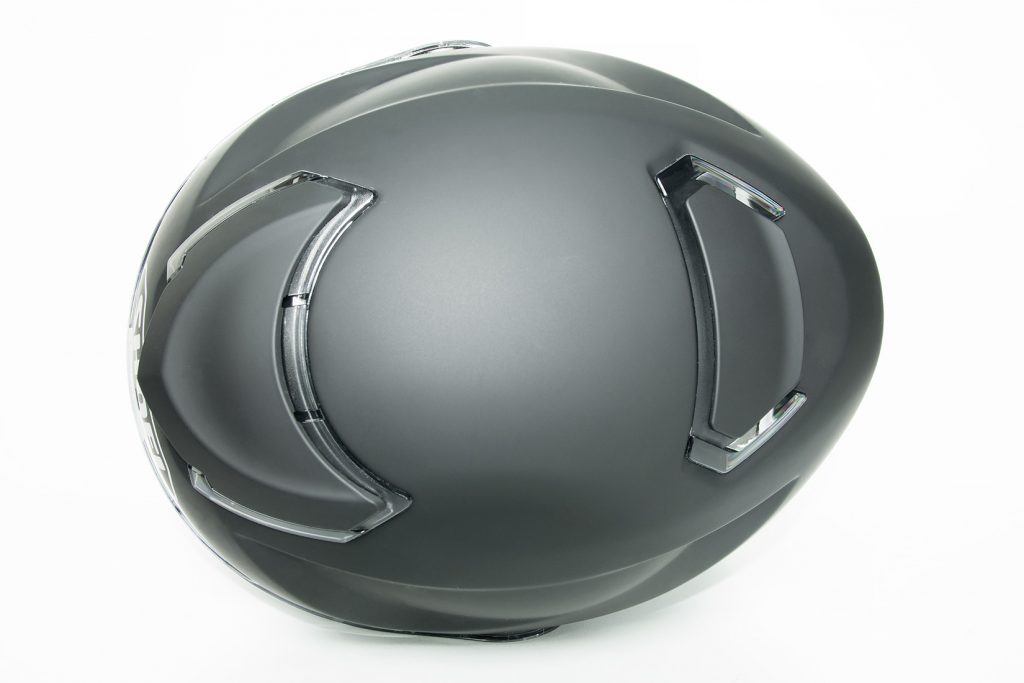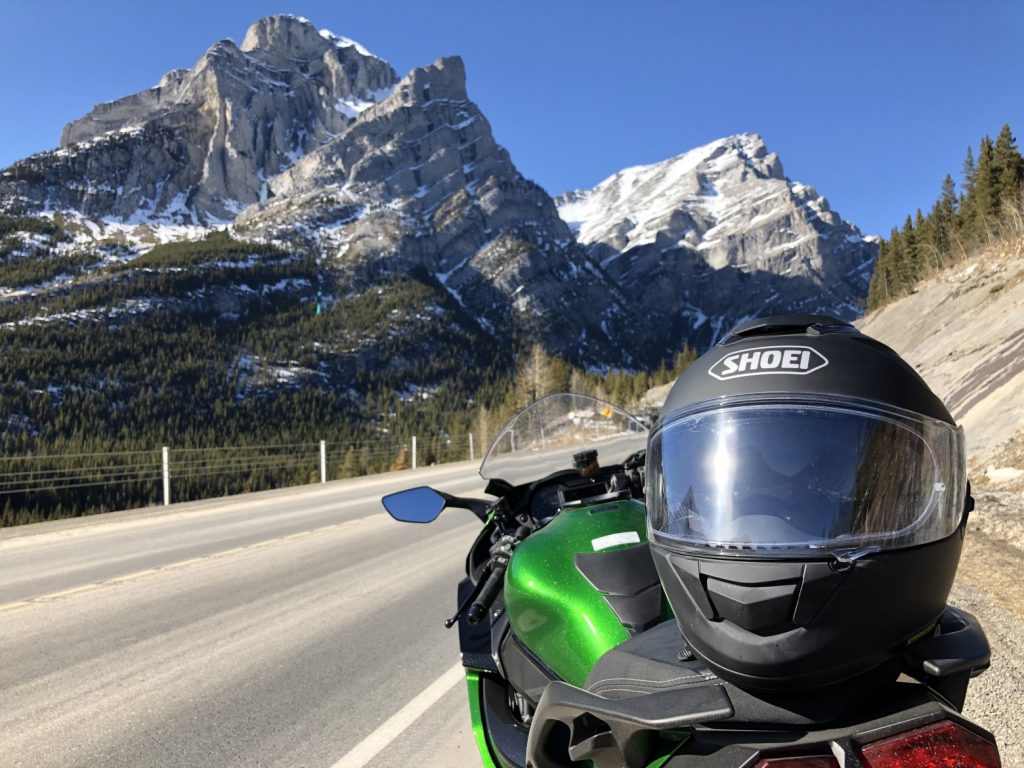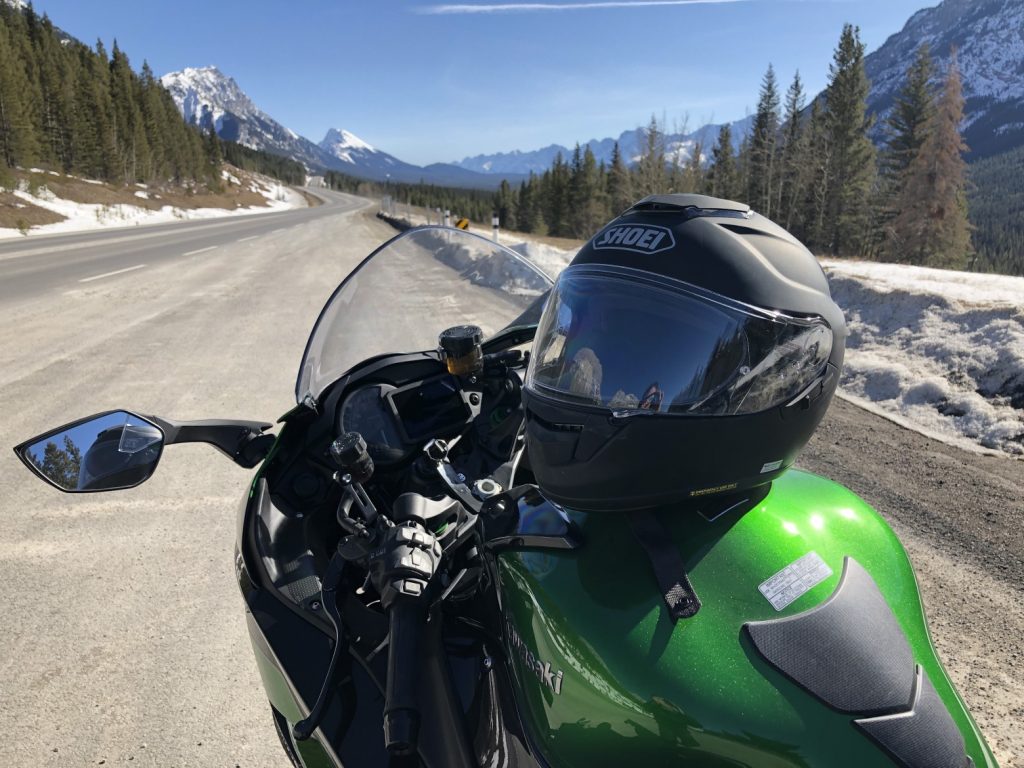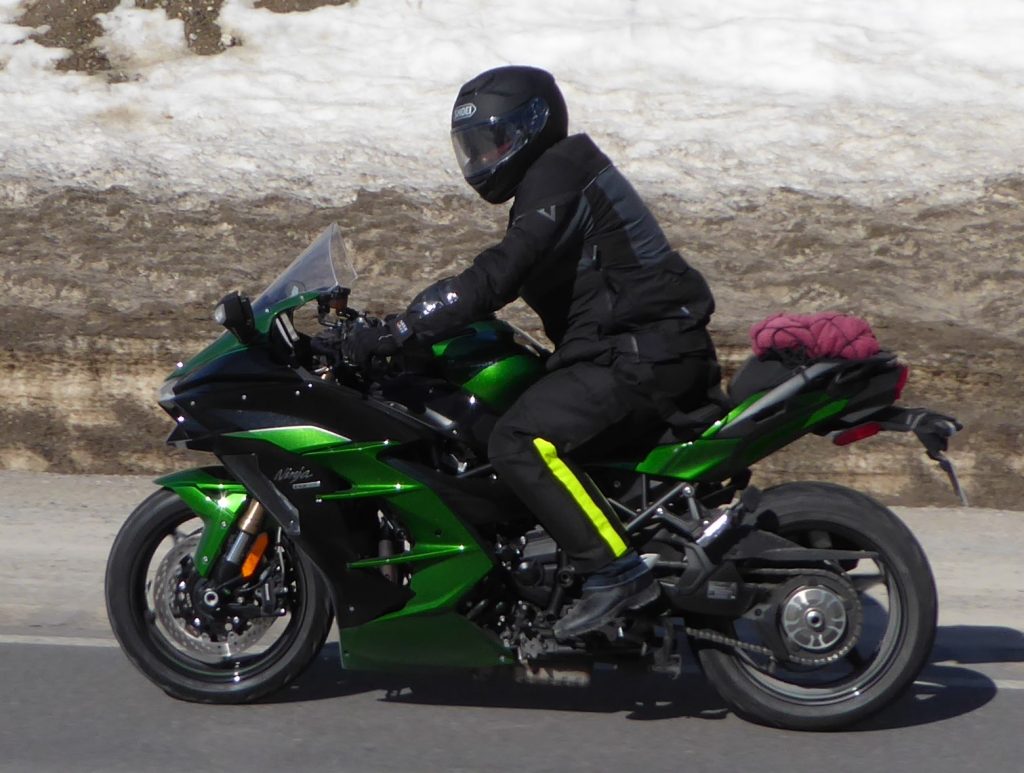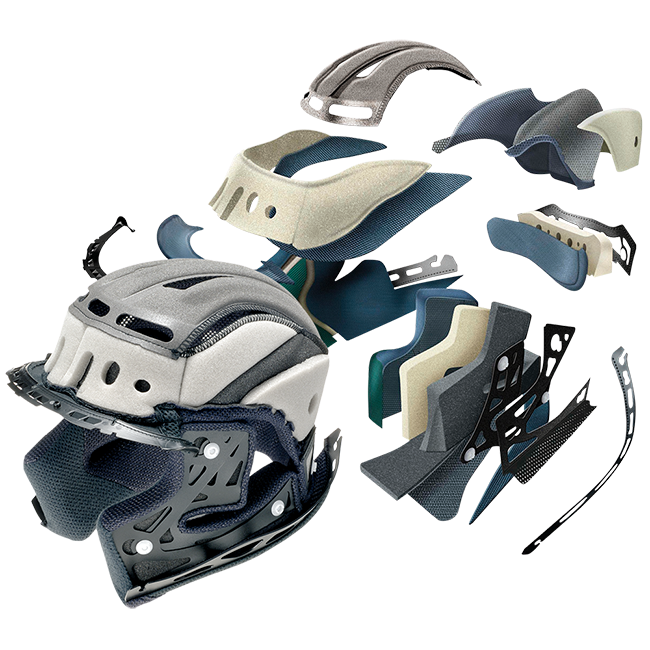Have I Gone Back In Time?
You’re probably wondering why I’m reviewing a helmet that was released in 2013, six years too late.
Fair question.
The answer: because the new GT Air II has just been released and everyone will be scrambling to buy it instead of this original GT Air helmet. A smart shopper who may not have $600 USD to spend on the new GT Air II will realize the opportunity here. Buy the old model for about HALF the money as retailers look to blow out old stock. Shoei handmade quality at the price of a Scorpion helmet? You can’t lose.
So what is the old GT Air like? Let me tell you!
Shopping Now? We Recommend:
First Impressions
Hold the GT Air in your hands and two things are immediately apparent about it. Lightweight and aerodynamic.
The design is simple and clean on this matte black version of Shoei’s GT Air. The sliders for opening vents on the chinbar, crown, and rear all look large and easy to manipulate too.
The standard SHOEI logo is branded were expected in the front right above the eyeport and there’s another smaller one on the back just above the DOT sticker. It’s there you’ll also find the stylized GT Air script with a hard right lean on it as if to emphasize the sport-worthiness of this helmet.
Shell Design
The exterior shell is a 5-ply aim matrix design available in 3 different sizes. These shells are hand laid fiberglass layers interwoven using organic fibers and resin.
That’s fancy talk from the Shoei website adding up to a finely crafted external shell that will be strong and fit uniformly.
Weight
That specific concoction of fiberglass is how Shoei keeps the GT Air light and strong. I weighed it on my scale and it came in at an astonishing 3lbs 2oz.
The 3lb mark is where I like to be when it comes to helmet weight because I find that’s the sweet spot for hardly noticing I’m wearing one.
Dents & Dings
The matte finish on this helmet is extremely prone to marking and scratching, unfortunately. It also shows every fingerprint far too easily. I managed to put a couple of dings in it without trying hard. Worst of all the layer underneath the black finish is bright white, so they show up like points of light in a midnight black sky.
It does have a grippy texture to the finish that I find makes it easier to hold on to and less prone to dropping.
Safety Rating
DOT vs ECE
This helmet easily meets DOT requirements as all Shoei helmets easily do, but I note this one doesn’t wear the ECE or SNELL approval stickers. Many helmets these days have both of those in addition to DOT and I decided to reach out to Shoei directly to ask why the GT Air doesn’t.
Their response was interesting. There’s another version of the GT Air sold in Europe which is just ECE compliant, but it’s different internally than this DOT only one we have here in North America. Shoei says in order to meet both DOT and ECE criteria it would mean increasing the weight by adding bulk for accommodating the two different testing demands. Doubling up wouldn’t make the helmet better or more protective in their eyes. All it would do is make it different. They’re confident a DOT or ECE only helmet is more than sufficient protection for the riding regular consumers require.
SNELL
They don’t feel the need to make the GT Air meet SNELL standards because this isn’t a helmet meant to reach racing speeds where a SNELL-level of protection is needed. It could be done, but again it would increase the weight unnecessarily.
Put another way, Shoei is saying it would be like using bulletproof glass in your car instead of standard tempered glass. It would be a lifesaver in the unlikely event someone shoots at you, but unless you happen to be a mobster you’ll likely never realize the benefits of the added weight, but would consistently suffer the undesirable negative effects.
SHARP Rating
SHARP is an independent helmet testing organization from the UK (similar to the US-based SNELL Memorial Foundation). SHARP rated the GT Air only 3 stars out of 5 in their testing noting poor performance by the helmet when impacted on the right and left sides.
This is a surprisingly low score for a Shoei helmet and unfortunately, they don’t provide any explanation as to the source cause. Frankly, I tend to doubt these findings but include them here in the interest of full disclosure. Note: SHARP would be testing the ECE only version of the GT Air, not the DOT one I’m reviewing.
I wonder how the DOT version would score in the same testing?
Multi-Piece EPS Foam System
Photo from Shoei
One really nice safety feature Shoei built into this helmet is the multi-piece foam system used instead of a single piece like in many other helmets. This allows them to tune the foam differently according to need in multiple areas appropriately.
Bluetooth Compatibility
There are pockets built into the foam around the ear area to better facilitate installation of aftermarket communication systems like SENA or Cardo units.
This foam is also built with channeling in it to allow better cooling airflow. More on that later.
Visor & Integrated Sun Lens
Visor
Photo from Shoei
The CNS – 1 visor is perfectly clear with no distortion built in whatsoever. My helmet came with about 4 small dents/scratches on the right side of the lens sustained in transit to me somehow. I thought these dots would be irritating to look through, but I was wrong. Amazingly I never noticed them thanks to the large and clear field of view this helmet has built in.
Shoei really does visors well in general. This one has 5 detented positions to lock it in place smoothly including a just slightly cracked open one. The visor won’t slam shut at any speed I tested it at even with full force wind acting on it. Several other premium helmets I’ve tested can’t make that claim.
This visor also is quite easily removed and installed from the helmet thanks to the simple lever locking system Shoei uses. Much simpler than the Arai visor releases which I would call the most finicky but not as simple as the easiest one found on the Schuberth C3 Pro.
Pinlock®EVO Included
Including the Pinlock® EVO fog-resistant system for the visor with purchase is a nice gift to you from Shoei. They cost around $60 USD or more to buy separately and make a huge difference in preventing foggy visors. I wasn’t able to fog up this visor even when I went riding in temperatures right around freezing and purposely exhaled out my mouth in an exaggerated fashion.
Read And Follow The Manual!
I didn’t follow the directions for installing the Pinlock lens and ended up paying for it.You’re supposed to carefully wash the lens and visor, then let them dry completely before installation. should the Pinlock be installed
The instructions additionally warn the inside of the Pinlock lens scratches easily. I found out even laying it face down across my lap was enough to damage it. Luckily even those scratches didn’t impede my vision while wearing it on the road, but I regret failing to take the directions seriously. Learn from me, friends!!
Sun Lens
The integrated QSV – 1 sun lens drops down smoothly using the slider switch located on the left side of the helmet just below and behind the visor hinge. I have used switches on other helmets with smoother action, but this one is plenty good all the same compared to the average.
The tint on the lens was perfect for me during most daylight hours and blocks 99% of UV rays as you would expect from a quality product. I do wish it came down about half an inch more to completely cover my field of view. I’ve heard many other people feel the same way about this. Shoei addressed this on the GT Air II by the way. Oops, spoiler!
Shopping Now? We Recommend:
Comfort & Fitment
Cheek Pads & Liner
Shoei does a fantastic job at providing several thicknesses of cheek padding for nearly all their helmets to ensure you can find a comfortable fit.
The soft and plush 3D max-dry liner material quickly absorbed and dissipated sweat from my head during my riding experience with it. Shoei claims it does this twice as fast as nylon, but I can’t really gauge that.
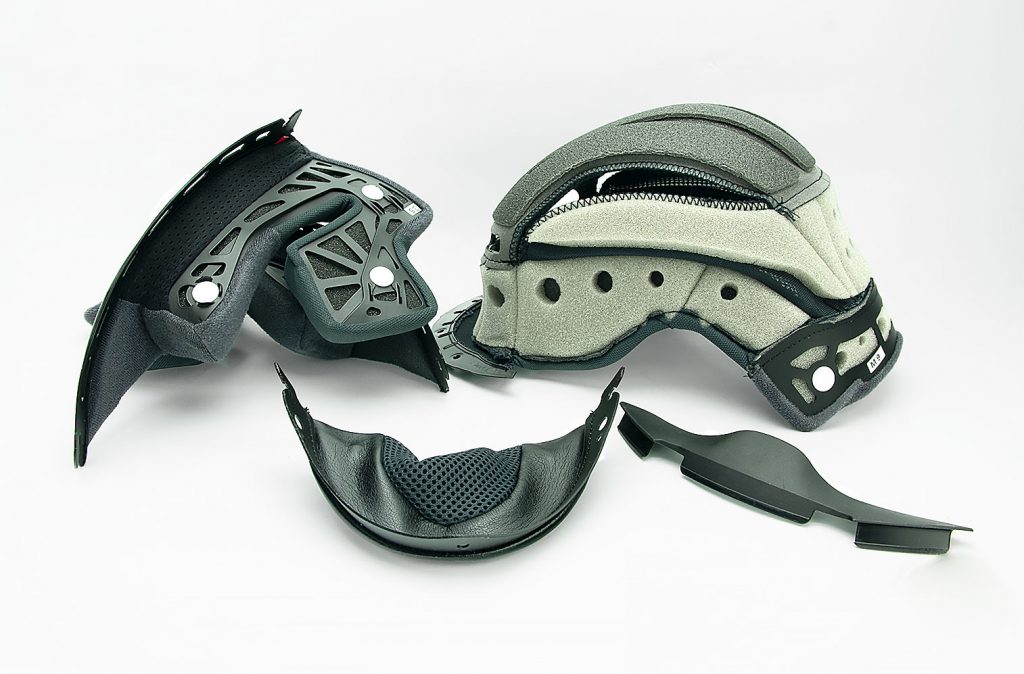
Ouch! Too Narrow
Here’s the only real problem I have with this helmet: the shape. This is labeled an “intermediate oval” shaped helmet, but my analysis of it tends to label it “semi-long oval”. That means the shape is narrow across the width or ear to ear dimension. See the photo below to better understand this. Bear in mind the images are slightly exaggerated to better illustrate the difference in head shapes.
Knowing your individual head shape will help you avoid wasting money buying helmets that just won’t be comfortable due to the way they’re built. Most people fall into the Intermediate Oval range with a varying degree of bias towards long or round.
Even the mundane task of pulling this helmet on and off is challenging for me due to the narrow opening on the bottom. Once I get my head through the opening I’m glad it opens up to provide ample space for my ears to unfold and live comfortably inside. There’s nothing more annoying than helmet padding that folds ears upon entry and leaves insufficient room for them to open up again.
Despite claims of having “three-dimensionally shaped padding to match the contours of a rider’s head” I found the GT Air very uncomfortable for my round oval shaped head after wearing it for an hour. As you can see in the photos of my cheeks the pressure acting on both sides of my head left noticeable indentation marks.
It Did Relax A Bit
After riding about 600 painful miles the padding on the right side let go a bit and I got some relief from the pressure on my temple area. It still isn’t nearly as comfortable as some of my other helmets, but Shoei informed me the GT Air II will be more of a neutral shape than this first generation GT Air is.
The bottom line here is that you’ll need to gauge your head shape and calculate where you fit into the matrix to know whether the GT Air will be comfortable for you. If you try it on you’ll need to wear it for at least 30 minutes to notice whether the pressure on your head will be there or not. I didn’t notice much at first and thought the fit was terrific for me if not a little on the tight side. That’s not a bad thing though. A brand new helmet should be quite snug.
Emergency Removal
The opening of the bottom of the helmet has a leather covering on it which is typically more durable than microsuede or nylon in my experience. This leather also will help stop the helmet from sliding around on smooth surfaces it gets set down on.
Standing out against that black leather are two bright red straps that are a part of the E.Q.R.S or Emergency Quick Release System. This allows paramedics to quickly remove all the padding from the inside of the helmet in the event of a medical emergency.
Chin Strap
This helmet comes with the standard double D ring chinstrap retention system that works flawlessly. For myself, I would prefer a ratcheting style closure for ease and speed when donning or doffing my lid.
On this particular chinstrap, I’m not fond of the snap placement used to tie up the excess strap material left over once the double D ring is closed up. I find the snap is located too close to the padding on the bottom of the helmet and it’s a bit challenging to connect. It’s especially hard to do while wearing gloves for me.
Ride Report
It’s time to take this Shoei out on the road! Riding gear often can look great in your living room or on a store shelf but leave a lot to be desired out in the elements.
Air Flow
This is a huge area of concern for many riders, myself included. I’ve worn more than a few helmets that leave me gasping for fresh air while riding, especially true in hot weather.
Photo from Shoei
I personally prioritize importance on the amount of airflow coming in from the chin bar vent for two reasons. Firstly it helps stop the visor from fogging up and secondly because when I get hot I want cool air flowing right at my nose and mouth to get relief.
The GT Air is outstanding at providing a steady stream of air even when the chin bar vent is closed. That flow goes upwards into the visor area and reflects gently back at my nose which I can’t praise enough.
Sliding the chin bar vent downwards to the open position doubles the airflow to your mouth and nose. Great job Shoei!
I was correct in my initial observation about the vents being easy to open and close even while wearing gloves.
Two Other Vents
The vent on top of the front of the GT Air has two open positions to fine-tune the amount of air sucked in and directed at your crown. If that’s not enough cooling you can reach back and slide open the rear vent to create a vacuum and draw out hot air.
I found the airflow up top much more subtle than the chin bar level experienced. I only tested this helmet in lower temperatures ranging from 32F (0 Celsius) up to a high of 65 F (18 Celsius) where it performed perfectly in keeping my head warm when I closed all the vents and cool when I opened them.
It’s important to note that I have short hair which would aid in airflow and cooling. I’ve gotten feedback from some other owners who have long hair saying this helmet can be on the hot side in high temperatures. If you live in a really hot climate and have long hair this may become a factor for you.
Lift & Pull
The back of the exterior shell comes to a point about ¾ of the way up from the wearer’s neckline. This is an aerodynamic fin and man does it work!
Even in strong crosswinds I never experienced any pull or lift on the GT air. It just slips through the airstream like a missile which helps prevent rider fatigue.
Full credit to the wind tunnel testing design team on this one.
Quiet… Very Quiet
As you can imagine having a helmet cut through the air without turbulence naturally makes it quiet to wear. In fact, this is the quietest helmet I’ve worn to date and I’ve worn more than a few.
I ride a Kawasaki Ninja H2SX SE that has a decent amount of wind protection provided by the windshield and fairings. That’s what I thought up until I rode it wearing the GT Air.
When I first got up to highway speed I noticed a fair bit of booming type noise going on and I actually thought the GT Air quite noisy as a result. When I stood up on my footpegs and leaned forward to stick my head out directly into the airstream in front of my windshield I got a surprise. I always do this to see how much noisier the helmet would get without the benefit of my bike’s windshield blocking for me.
Holy moly… my jaw dropped open in complete shock when all the booming and low frequency flapping noise went away only to leave a very quiet high pitched “hisssssss” in its place. Even when I tipped my head downwards this helmet didn’t get significantly louder.
Chin Curtain
Remember how I mentioned the small opening on this helmet making installation of it on my head difficult? Paying that price helps keep this helmet quiet out on the road. The small opening and tight fit means it will seal better around the jawline, thus keeping air from entering, creating turbulence and buffeting.
The nylon chin curtain at the front also helps with this a lot. It adds to the discomfort of donning the helmet when it catches and drags on your face but is so worth it once the helmet is on fully.
This really is the perfect helmet to wear on a naked sport bike or any other where you don’t get much protection from a windshield. I’m still in shock at just how good it is.
Whistling Noise
Shoei uses excellent rubber to seal around the visor when it’s closed and they take seriously the job of making their helmets watertight around that seal. So seriously in fact that they include silicone lubricant with this helmet to use on the rubber seal.
I found that if I didn’t smear it around the rubber gasket I would experience a whistling noise out on the bike that was coming from the visor edge letting air through
If you do buy one of these helmets you definitely will want to take the time to do your seal maintenance.
The Final Verdict?
What an excellent design! I’m bitterly disappointed by the fact my head shape isn’t suited to the GT Air.
It is my favorite full face helmet I’ve had the opportunity to test until now, but next up for me will be the GT Air II which could potentially win over this one. It’s going to be interesting judging whether the new upgrades on it are worth almost twice the money as this original version. I’m hopeful it will fit me better and become my everyday helmet of choice.
As I mentioned at the start of this review if you can wear this narrow helmet comfortably it can be purchased now at a bargain basement price. Don’t hesitate to go try this one out and see.
Pros
Quieter than most helmets / Pinlock included / Excellent Airflow / Lightweight / Internal sun visor / A bargain-priced high end helmet / 5 year warranty
Cons
Semi-Long Oval Shape / Too warm in summer riding / Finish scratches easily / Whistling noises? / Protection level in question?
Specs
- Manufacturer: Shoei Helmets
- Price (When Tested): $549 USD regularly but on sale for $371 to $400 currently
- Made In: Japan
- Alternative colors: six colors in solid model
- Review Date: April 12, 2019

